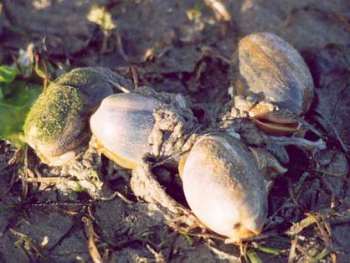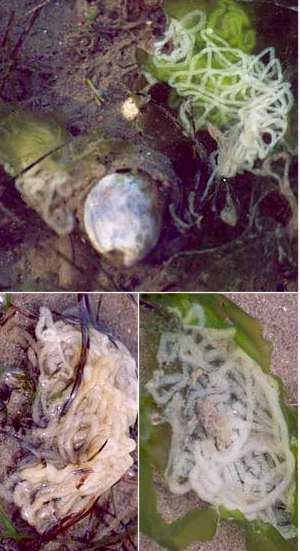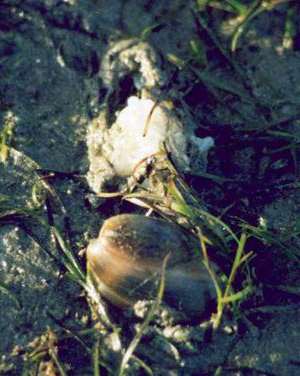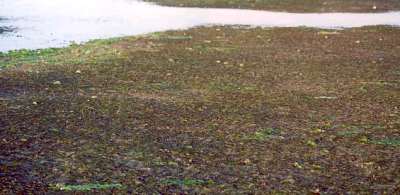Bulla quoyii - breeding observations
November 18, 2003
From: Paul Furneaux

Upper Photo: breeding aggregation.
Lower Photos: showing egg strings and animal laying an egg string.
Dear Bill,
At last Bulla quoyii has been in action in a fairly spectacular way here in Tauranga [New Zealand]. As you know I've been keeping an eye on its activities as part of my Royal Society Teacher Fellowship and during this month (November) it has begun its reproductive cycle with gusto. Prior to this month I would record beteween 5-10 individuals from an area of about 14,000 sq.m, but during the last week on three separate visits I have recorded from 25-270 individuals from a smaller area of 5,600 sq.m, an area that was used by Aplysia juliana earlier in the year for its reproductive purposes. The most exciting thing for me is to see their egg strings, from 95-230 per visit so far. These egg strings are reminiscent of the Aplysia egg strings but are smaller in volume (about 5cm by 5cm by 2cm) and a pale white to cream in colour. Each string is about 2mm in diameter and contain a spiral string of capsules which under the microscope show one embryo per capsule (unlike the Aplysia strings which seem to have from 20-40 embryos per capsule) Each capsule is about 300um in diameter and the 2-day old embryos were about 125um in diameter. Within 7-8 days the capsules contain active veligers and these may possibly be released after 2 weeks (yet to confirm)
I had been expecting the sac-like egg mass with red coloured eggs as described in Willan & Morton, 1984, but these egg strings are rather different, more reminiscent of anaspidean egg strings than cephalspidean egg masses. The behaviour of Bulla in this "breeding ground" area is also interesting, they have definitely massed together within a particular area, this area being at the low tide mark with abundant Zostera, Ulva and some Enteromorpha ramulosa. Their are pools and tidal-streams surrounding the Zostera banks and other species found here include Haminoea, Atrina, Arachnoides and Chaetopteris. Often they rest in their usual half-buried pose, but in clusters of 3-6 individuals and such groups may be seen both in and out of the water at dead low tide. Their egg strings are attached to Ulva usually but also to Zostera, and in some cases their egg string was still emerging even as the animal was exposed by the receding tide, although most egg strings seem to be placed in pools that never dry out.
I hope that the photos [taken on 15 November 2003] show most of what I've described, I was so stunned by the egg strings that I kept two animals in my aquarium at home and sure enough they have obliged by producing 3 separate egg strings during the past week. Bulla has been so challenging that when something like this happens it seems too good to be true. Hope that you enjoyed your holiday in NZ.
• Willan, R. & Morton, J. (1984) Marine Molluscs. Part 2. Opisthobranchia. Leigh Marine Laboratory, University of Auckland, New Zealand.
Regards from
Paul Furneaux.
P.Furneaux@xtra.co.nz



Photo: Zostera bank where Bulla were found breeding.
Dear Paul,
This is very interesting news. I have wondered about Willan & Morton's egg mass description which I suspect is that of a polychaete worm. I found egg strings like in your photos but could never positively link them to Bulla. It is really good that they obliged and produced egg strings in an aquarium for you. This egg mass is similar to that described for the North American Bulla gouldiana, and to Erwin Koehler's photos of what he suspects are the eggs of Bulla ampulla. I am glad you have been able to finish your project on such a high note.
Best wishes
Bill Rudman
Related messages
-
Re: Bulla quoyii from New Zealand
From: Graham Bould, December 18, 2008 -
Bulla quoyii - mass mortality
From: Paul Furneaux, December 9, 2003 -
RE: Bulla quoyii - breeding observations
From: Rachel Przeslawski, November 19, 2003 -
Handy Hints for finding Bulla quoyii
From: Paul Furneaux, November 14, 2003 -
Bulla quoyii from South Australia
From: John Chuk, September 3, 2003 -
Re: Bulla quoyii from New Zealand
From: Audrey Falconer, September 2, 2003 -
Bulla quoyii from New Zealand
From: Paul Furneaux, September 1, 2003
